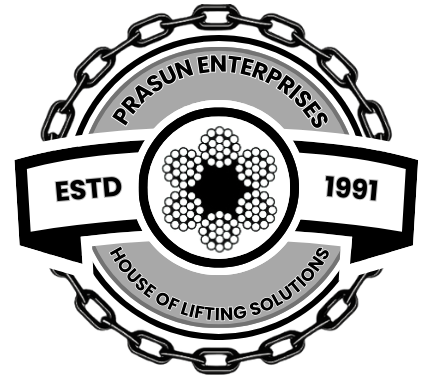
When it comes to lifting and pulling equipment, reliability and safety are vital. Webbing slings are a vital component in these operations, offering the strength and flexibility required to handle heavy loads with accuracy. In this blog post, we are going to dive into the material and design for webbing slings, shedding light on their construction and the materials that make them the backbone of quality in the world of lifting and pulling equipment.
Understanding the Materials Usage
Webbing slings are ordinarily made from synthetic materials designed to offer high tensile quality, flexibility, and toughness. The most common materials utilized in webbing sling construction include:
- Polyester (PET): Polyester is a well-known choice for webbing slings due to its exceptional strength and resistance to stretching. It is also known for its resistance to moisture and chemicals, making it appropriate for a wide range of applications. Polyester webbing slings are regularly color-coded for simple identification and come in different widths and thicknesses to coordinate particular load requirements.
- Nylon (PA): Nylon webbing slings are prized for their superior flexibility and shock-absorbing qualities. They provide excellent quality and are highly safe to abrasion. While nylon is not as resistant to moisture as polyester, it is still a dependable choice for numerous lifting and pulling applications. Nylon webbing slings are regularly chosen when loads require some delivery or when shock loading is expected.
- Polypropylene (PP): Polypropylene webbing slings are lightweight and offer great resistance to chemicals. However, they are less strong in terms of ductile quality compared to polyester and nylon. Polypropylene slings are often chosen for applications where weight may be a basic thought, such as within the sailing and marine industry. They are moreover less inclined to build up growth, making them suitable for some outdoor applications.
- Ultra-High Molecular Weight Polyethylene (UHMWPE): UHMWPE webbing slings are known for their remarkable strength-to-weight ratio. They are fantastically lightweight, however they offer amazing ductile quality. These slings are safe to abrasion and have low stretch properties. UHMWPE webbing slings are perfect for lifting and pulling tasks where minimizing the weight of the equipment is a priority.
- Kevlar: Kevlar is a high-performance fabric known for its quality and resistance to extraordinary temperatures. It is frequently utilized in specialized webbing slings designed for applications in unforgiving environments, including high-temperature settings like steel mills and foundries.
The Design of Webbing Slings
The design of webbing slings is a basic viewpoint that specifically impacts their performance and reliability. Here are key design features to consider:
- Layered Construction: Webbing slings are regularly designed with numerous layers of synthetic material. The layers are carefully woven together to make a tough and strong sling. The number of layers and their arrangement can change based on the expecting load capacity and application.
- Stitching Patterns: Stitching is a necessary part of the design, because it secures the layers of webbing together. High-quality webbing slings utilize strengthened stitching patterns that convey the load equally across the sling, decreasing the chance of failure.
- Strengthened Edges: Strengthened edges help prevent fraying and damage to the webbing sling. These strengthened edges also improve the overall toughness and life span of the sling.
- Eye Loops and End Fittings: Webbing slings are designed with eye loops at the ends, which give connection points for hooks, shackles, or other lifting equipment. The design of these eye loops guarantees a secure connection, empowering effective and safe lifting and pulling operations.
- Color-Coding: Numerous webbing slings are color-coded to show their capacity and type. This color-coding system simplifies recognizable proof and choice, helping clients to choose the correct sling for their specific needs.
- Length and Width Varieties: Webbing slings come in a range of lengths and widths to suit different load sizes and arrangements. The design of the sling should adjust with the load’s measurements and weight.
- Labels and Certifications: High-quality webbing slings include labels that give vital data, such as Working Load Limits (WLL), security guidelines, and certifications. These labels guarantee that the sling complies with industry guidelines and security directions.
- Anti-Abrasions & Coatings: Some webbing slings include anti-abrasion coatings or treatments to advance and improve their resistance to wear and tear, expanding their service life.
- Testing and Quality Control: Dependable manufacturers subject webbing slings to thorough testing and quality control measures to guarantee that each sling meets its specified design and performance standards.
The material and design for Webbing Slings ensures secure and efficient heavy load transportation. Fabric selection is based on the task at hand, with options ranging from lightweight nylon and polyester to super-durable polyester and UHMWPE.
Conclusion:
The material and design for webbing slings are the pillars of quality and strength in the realm of lifting and pulling equipment. They are fastidious designed to withstand the demands of different applications, guaranteeing the security and productivity of heavy load transportation. Whether it’s the flexibility of nylon, the resistance of polyester, or the lightweight quality of UHMWPE, the choice of fabric is coordinated to the particular necessities of the task at hand. The design features, such as layered development, stitching designs, and strengthened edges, encourage to improve the overall execution and reliability of these irreplaceable tools. Understanding the fabric and design of webbing slings guarantees that they can be trusted as the spine of secure and dependable lifting and pulling operations.

